|
Trimble's dynamic 2019 lineup
An overview of Trimble Mobile Computing Solutions' latest additions to their tough and rugged hardware lineup, the Yuma 7, Ranger 7, and Nomad 5
(by Conrad H. Blickenstorfer)
Share on:




Some things never change. One of them is the need for good tools. Stuff that's just right, that doesn't break, that you can rely on. That goes for hammers, screwdrivers, hacksaws, anything. And it also goes for computers. What you use out there in the field must be just right, a tool for your job. Today's consumer tech is awesome, but even if you stick it in a case, it just wasn't built for work out there. It's too flimsy.
The folks at Trimble have known that for many decades. As has their Mobile Computing Solutions Division, which began life as Tripod Data Systems in 1988 and was acquired by Trimble in 2000. At the time, Trimble said "the move to acquire TDS reinforces our information strategy by bringing a strong software capability, a low-cost data collection hardware platform and an enhanced pen-based computing solution." While the emergence of capacitive multi-touch has de-emphasized the need for pens, strong software and just the right hardware to run it on is more important than ever.

It's almost two decades later now, and Trimble MCS certainly has delivered. Their lineup of field data collection systems is among the very best. In this article we're looking at a trio of remarkable new additions to Trimble's lineup of computing tools for the job, all brand-new designs and introduced late 2018 and early 2019: these are, shown above from left to right, the Yuma 7, the Ranger 7, and the Nomad 5.
Trimble's new lineup of field computing solutions
Trimble offers a more diverse lineup of field computing solutions than almost anyone else. Nowhere is that more evident than in the company's Ranger 7 that looks like a large handheld. But even Trimble's products that fall into more conventional classifications — the Yuma 7 tablet and the Nomad 5 handheld — eschew the standard consumer tech design mantra in favor of building form around function rather than squishing function into form. In other words, Trimble makes tools, not fashion statements.
Before we go into the specifics of each of these three platforms, the table below provides an overview of the major specs of each.
|
Trimble
|
Yuma 7 (2019)
|
Nomad 5 (2018)
|
Ranger 7 (2018)
|
|
|
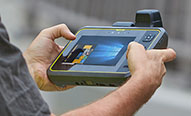
|
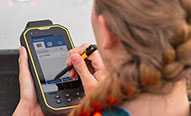
|
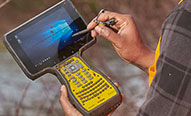
|
|
Device type
|
Tablet
|
Handheld
|
Tablet/handheld
|
|
Ruggedness
|
Fully rugged
|
Fully rugged
|
Fully rugged
|
|
Display/Resolution
|
7.0" (1,280 x 800)
|
5.0" (720 x 1,280)
|
7.0" (1,024 x 600)
|
|
Display/PPI and Luminance
|
216ppi, 800 nits
|
294ppi, 830 nits
|
216ppi, 650 nits
|
|
Operating System
|
Windows 10
|
Android 8.1
|
Windows 10
|
|
Keypad
|
4 programmable keys, navigation diamond, enter, Windows key
|
6 programmable keys
|
Backlit QWERTY or ABCD, numeric key block, Fn keys (6 physical + 6 2nd function Fn keys)
|
|
Processor
|
Intel Pentium N4200
|
Qualcomm SnapDragon 820
|
Intel Pentium N4200
|
|
Thermal Design Power
|
6.0 watts
|
Unknown
|
6.0 watts
|
|
RAM/Storage
|
8GB RAM, 128GB SSD
|
4GB RAM, 64/128GB SSD
|
8GB RAM, 64GB SSD
|
|
Battery
|
2 x 22.9 watt-hours
|
35 watt-hours
|
2 x 21 watt-hours
|
|
Size
|
9.65 x 6.5 x 2.0 inches (245 x 165 x 50 mm)
|
7.9 x 3.76 x 1.73 inches (200 x 95 x 44 mm)
|
11.8 x 8.1 x 1.8 inches (300 x 205 x 47 mm)
|
|
Weight
|
3.0 lbs w/ 2 batteries
|
1.54 lbs w/ battery
|
3.1 lbs w/ 2 batteries
|
|
Fan
|
No
|
No
|
No
|
|
Drop spec
|
4 feet
|
6 feet
|
4 feet
|
|
Operating temperature
|
-20° to 60°C (-4° to 140°F)
|
-30° to 60°C (-22° to 140°F)
|
-20° to 60°C (-4° to 140°F)
|
|
Operating altitude
|
30,000 feet
|
30,000 feet
|
15,000 feet
|
|
Ingress protection
|
IP68
|
IP68
|
IP68
|
|
Cameras
|
2.0mp/8.0mp
|
8.0mp/16.0mp
|
2.0mp/8.0mp
|
|
Expansion
|
microSD Card, 2 x EMPOWER
|
microSD Card, 1 x EMPOWER
|
microSD Card, 2 x EMPOWER
|
While Trimble's three new field computing platforms are visually and functionally very different from one another, they also have a lot in common. All three are fully rugged, have substantial on-board battery power, have sharp sunlight-viewable displays, and can be expanded via Trimble EMPOWER modules (more on those later).
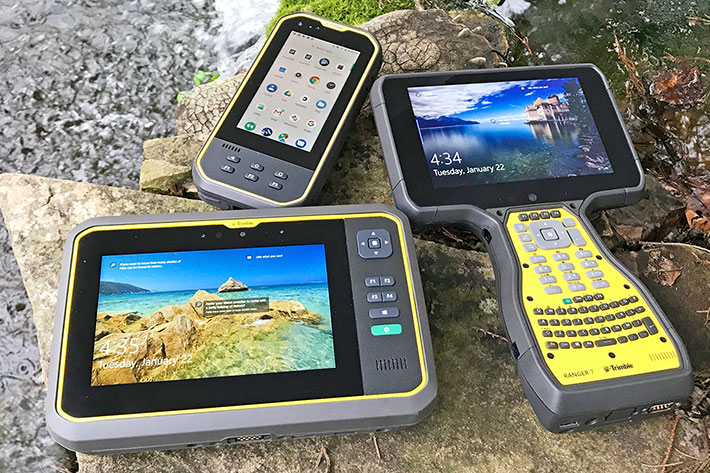
The Trimble Yuma 7 — 7-inch Windows 10 tablet
What is the Yuma 7 for? The short answer is having full Windows 10 Professional power, functionality and security out there in the field, and in a tablet form factor that's small and handy enough to not get in the way and go almost anywhere. The Yuma 7 is for people who know they can't take an iPad or consumer Android tablet on jobs where it may get wet and dirty and the tablet may get dropped, and where you work in the sun and still need to see what's on the screen.
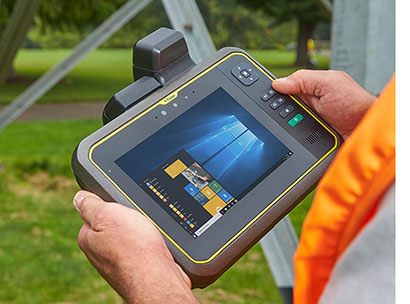 But with all consumer tech so slim and light and sleek, why is the Yuma 7 still comparatively big and hefty, and has hardware buttons and a big bezel around the screen? That's mostly because it's very rugged and doesn't need a bulky case just to use on the job. And also because it has standard USB ports for when you need them, offers plenty of expansion, and has easily replaceable batteries that can be changed in seconds. But with all consumer tech so slim and light and sleek, why is the Yuma 7 still comparatively big and hefty, and has hardware buttons and a big bezel around the screen? That's mostly because it's very rugged and doesn't need a bulky case just to use on the job. And also because it has standard USB ports for when you need them, offers plenty of expansion, and has easily replaceable batteries that can be changed in seconds.
Yes, the bezel area is pretty large, but that makes the Yuma 7 easier to hold and easier to operate than trendy consumer tech that, weirdly and for no apparent purpose, no longer has a bezel.
And there are physical buttons and a physical navigation diamond because in the field, with gloves on and in the rain, it can be much better to have buttons to push than taking a chance with tapping and swiping on a touch screen.
So as a result of all that, the Yuma 7 measures 9.65 x 6.5 inches, it is two inches thick and it weighs about three pounds, considerably more than a non-rugged consumer tablet. The housing has a grippy rubberized surface that, in combination with the two battery "bulges," makes it easy to hold. Users won't have to guess where the tablets ports are and which port may hide under what protective cover; they all face down, and they are open (albeit very well sealed) and not behind covers.
The composite below shows what the Yuma 7 looks like from the front and from all four sides:
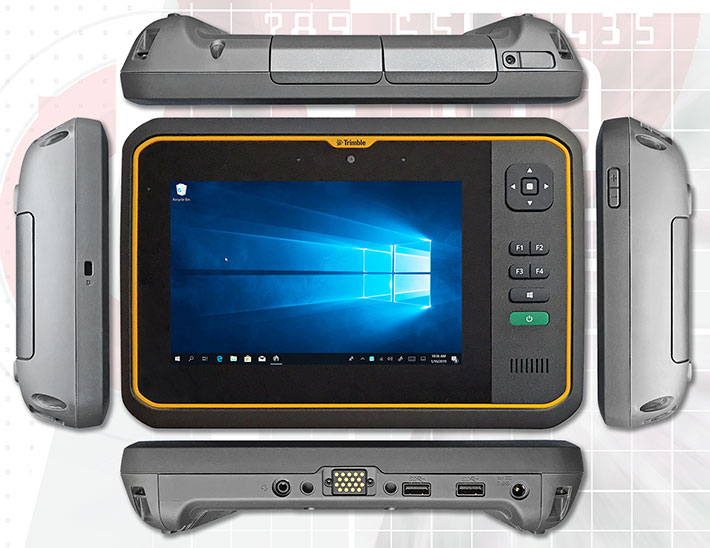
It's a very functional and no-nonsense design that conceptually remains the same as that of earlier Yumas. The third-gen Yuma is still dark gray but the previously abundant yellow has been reduced to a thin line around the perimeter of the front fascia. As in earlier versions, there are still programmable function buttons (albeit no longer shiftable as in the Yuma 2) and a navigation diamond.
On the bottom is still a surface-mount contact for future Yuma 7 peripherals. You can see the two USB 3.0 ports (black instead of the usual blue that signifies USB 3.0) and a combo audio jack. The HDMI port of the Yuma 2 is gone, as is the original Yuma's serial port. With USB 3.0 and adapter cables, extra ports are no longer necessary.
The Trimble Nomad 5 — 5-inch Android handheld
The Nomad 5 is a rugged handheld computer designed for people who work outdoors. It is built to take the kind of abuse that can happen in the field: dust, water, drops, vibration and so on. It is also built to run for a long time on a single charge, and to accommodate a variety of connections and peripherals.
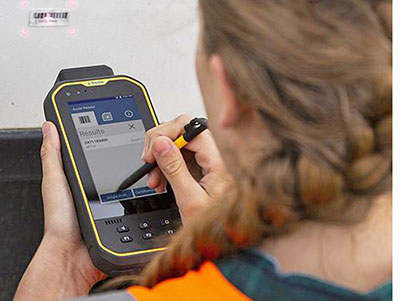 While the powerful, versatile Nomad 5 obviously isn't as thin and light as a consumer smartphone, it's remarkably compact with a footprint of 7.9 x 3.76 inches. It weighs a bit over a pound and a half, and is an inch and three quarters thick. While the powerful, versatile Nomad 5 obviously isn't as thin and light as a consumer smartphone, it's remarkably compact with a footprint of 7.9 x 3.76 inches. It weighs a bit over a pound and a half, and is an inch and three quarters thick.
Like Trimble's other mobile computers, the Nomad 5 sports a utilitarian but ruggedly handsome design born of a few very simple tenets. A virtually invulnerable shell protects the electronics inside. A module bay allows extensive customization.
The device is built to operate in extreme temperatures and survive drops, vibration, altitude, corrosives, dust and more. It's impervious to dust and liquids, and even full immersion.
What also sets the Nomad 5 apart is that it's from Trimble, the US$2.7 billion (2017) positioning technology specialists known for their GPS and other measuring hardware and software used worldwide. For Trimble, GPS is not just a feature. It is the feature (the Nomad 5 can achieves sub-meter positioning when paired with the Trimble R1 GNSS receiver or the Trimble EMPOWER GNSS receiver module).
The composite below shows what the Nomad 5 looks like from the front and from all four sides:
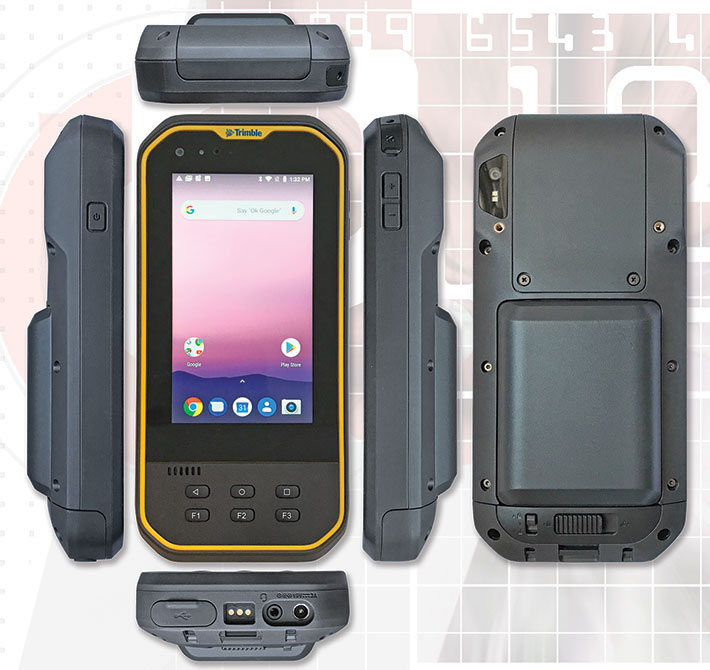
While consumer smartphone and industrial handheld computer technologies have diverged in recent years, the invulnerable Nomad remains an eminently practical, powerful handheld computer for surveying, mapping, scanning, communicating, and data capture. The applications are endless, and no matter where the machine is deployed, it can handle any abuse that comes its way.
The Trimble Ranger 7 — something new and different
Trimble describes the Ranger 7 as a fully-rugged field handheld computer for professional organizations that know they can't afford to take shortcuts, and that the Ranger 7, combined with specialized software, defines the next generation of data collection and computing for mobile workers.
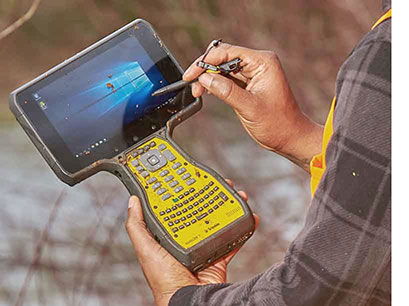 And the Ranger 7 is new and different indeed. While a first look at a picture of the device may suggest a standard flashlight-style handheld with a landscape display, the Ranger 7 is a very unique animal. What Trimble did here is take a 7-inch tablet and merge it with a large handle that includes both a small QWERTY keypad as well as a separate numeric keypad and function keys. And the Ranger 7 is new and different indeed. While a first look at a picture of the device may suggest a standard flashlight-style handheld with a landscape display, the Ranger 7 is a very unique animal. What Trimble did here is take a 7-inch tablet and merge it with a large handle that includes both a small QWERTY keypad as well as a separate numeric keypad and function keys.
As a result, the Ranger 7 is much larger than your standard flashlight handheld. It can be used like a handheld, though at 3.1 pounds it's a big, hefty one. It can also be used as a tablet, as its 7-inch screen sports 10-point capacitive multi-touch. That means users can tap, pan, zoom and pinch like on any smartphone or consumer tablet. Or the Ranger 7 can be placed on a desk and used like a laptop, sort of.
Trimble says the device was designed based on customer feedback. This suggests that customers like the handheld flashlight-style form factor but wanted a much bigger screen and a more powerful computer. Trimble obliged and combined all of this into one device. As a result, the Ranger 7 measures 11.8 x 8.2 x 2.8 inches and is quite unlike anything else out there.
The composite below shows what the Ranger 7 looks like from the front and from all four sides:
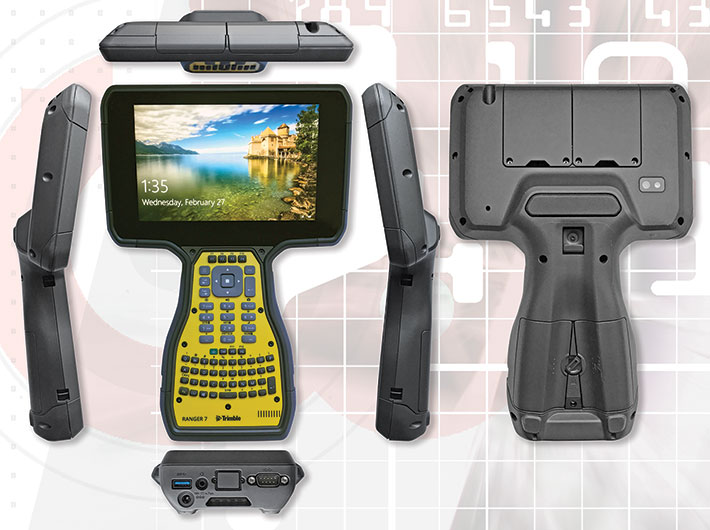
With the Ranger 7, Trimble adds an interesting, unique field computer/solution for large scale field data capture in nearly any industry and application. By merging a modern Windows 10 tablet with a spacious traditional keypad handle, Trimble seeks to address the needs of professionals who run dedicated software such as Trimble Access 2018 and Trimble Sync Manager, but also like the speedy, effortless data entry afforded by a flashlight-style handle with keypads.
Ruggedness
In terms of ruggedness, Trimble indicates a very wide operating temperature range of -4 (Yuma 7, Ranger 7) and -22 (Nomad 5) to 140 degrees Fahrenheit, and MIL-STD-810G performance for drops, vibration, and humidity. You can tell from the looks alone that these are nicely protected machines. Meticulous design and construction, and solid state disk instead of rotating media mean the Yuma 7 and Ranger 7 can survive multiple 4-foot drops, and the smaller and lighter Nomad 5 even falls from six feet.
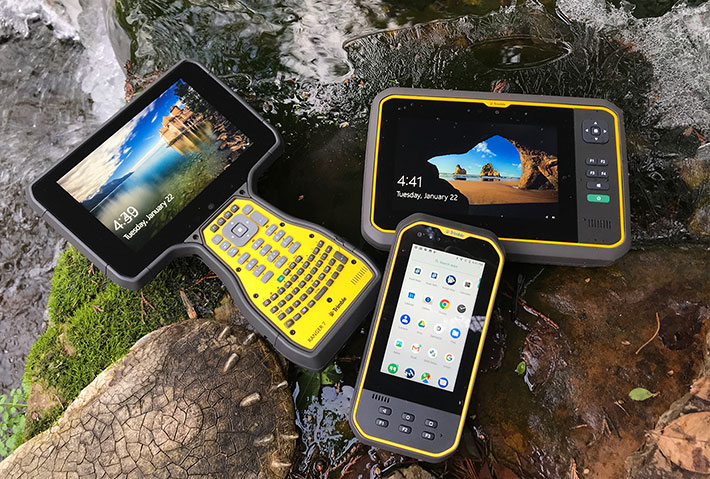
While Trimble's earlier Ranger, Nomad and Yuma models carried IP65 or IP67 ingress protection ratings, all three new models sport impressive IP68 protection. That's as high as it gets short of wearing a dive computer. The "6" means total protection against dust, and the "8" that it can handle extended time fully immersed. So that means that while earlier units could handle low pressure water jets from all directions (IP65) or even limited full immersion (IP67), the new units can withstand a waterfall and survive a fall to the bottom of a stream, even if it takes a while to retrieve them.
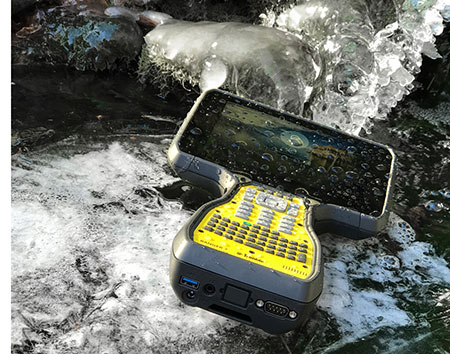 Trimble clearly describes on its website its hardware test standards and lists which of its rugged handhelds and tablets passes what level of abuse (see here). Testing includes the following MIL-STD-810G sections: Trimble clearly describes on its website its hardware test standards and lists which of its rugged handhelds and tablets passes what level of abuse (see here). Testing includes the following MIL-STD-810G sections:
- Immersion in Water
- Sand and Dust
- Shock/Drop
- Vibration
- High Temperature
- Low Temperature
- Temperature Shock
- Humidity
- Low Pressure/Altitude
- Solar Exposure
Eagle-eyed customers may wonder how Trimble can achieve dust- and waterproof sealing with easily accessible and fully exposed ports without protective covers.
That's accomplished by combining all ports into a separate I/O module that communicates with one single sealed connector to the interior of the devices. No external port covers are needed. This way users never have to worry about often flimsy and fingernail-busting port covers.
Empowered by EMPOWER modules
One important thing that Trimble's three latest field computing platforms have in common is their ability to add functionality via what Trimble calls EMPOWER modules. The Windows-based Yuma 7 and Ranger 7 can accommodate two such modules, the smaller Android-based Nomad 5 one. Below you can see the three platforms each equipped with EMPOWER modules.
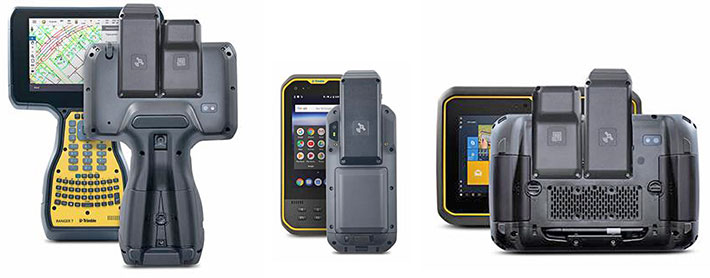
Why did Trimble decide to use this approach? Why not simply build all anticipated functionality into the devices? Because it's not economically feasible nor practical to integrate every conceivable interface a customer might need into a device. So Trimble built the current default wired and wireless I/O (Wi-Fi, Bluetooth, USB, audio) into the devices, but also provided a standardized interface for extended functionality in the form of bolt-on modules. These modules can contain any conceivable type of functionality, including interfaces, sensors, calibration, or entire solutions.
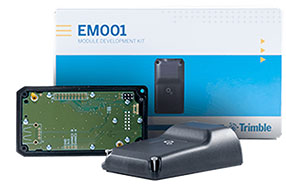 So what are EMPOWER modules all about? They measure roughly 4-1/2 x 2.0 x 0.75 inches, attach to a Trimble device via four Phillips screws, and have a standardized 12-pin connector. As of this writing (March 2019), Trimble itself offers three EMPOWER modules. These provide high-sensitivity GNSS (see here), 1D/2D barcode reading, or 1D/2D barcode reading and RFID reading combined (see here). So what are EMPOWER modules all about? They measure roughly 4-1/2 x 2.0 x 0.75 inches, attach to a Trimble device via four Phillips screws, and have a standardized 12-pin connector. As of this writing (March 2019), Trimble itself offers three EMPOWER modules. These provide high-sensitivity GNSS (see here), 1D/2D barcode reading, or 1D/2D barcode reading and RFID reading combined (see here).
Trimble also offers the Trimble EMPOWER developer program that provides access to all the documentation needed to enable development of custom or reseller solutions.
Joining the developer program is free of charge and allows access to the EMPOWER SDK, APIs, interface specifications and developer support files, and other resources. On the hardware side, Trimble sells Module Development kits that either include a single housing and developer board, multiple unit housing assembly kits, or multiple unit housing assembly kits plus USB interface circuitry.
Third party solutions must be Trimble-approved, but can be sold by third parties individually or bundled with Trimble hardware.
Summary: Trimble's 2019 lineup
Trimble Mobile Computing Solutions has a long history of providing practical, reliable field data collection solutions that are tools for the job. And because those jobs pose different challenges and require different functionality and capabilities, Trimble always offered state-of-the-art technology and solutions in a variety of packages and form factors.
This tradition is upheld in Trimble's most recent (2018/2019) additions to their growing lineup of mobile computing hardware solutions, the Ranger 7, Nomad 5, and Yuma 7 (shown below).

The three new models complement existing products (the Ranger 3, Nomad 1050, and Juno T41 handhelds, and the Yuma 2 and Kenai tablets) and may eventually replace some of them. The newcomers also provide transition paths from older hardware and operating system platforms, as well as performance and functionality upgrades.
The Nomad 5, in particular, will be of interest for customers seeking migration from older Windows Mobile platforms to Android, whereas the Ranger 7 and Yuma 7 bring full Windows 10 functionality and considerable processing power into the field.
While offering different form factors, all three new models bring to the table core values such as rock-solid build, large and easily replaceable batteries, sunlight-readable displays, and immunity to both the elements and daily wear on the job.
Add to that the availability of unlimited expansion and customization via open-source EMPOWER modules compatible with all three new models, and Trimble Mobile Computing Solution's "Transforming the mobile workplace through innovative computer equipment designed for the field" tag line seems both appropriate and almost a bit too modest. -- Conrad H. Blickenstorfer, March 2019

|






